Timeline: How Bunker Hill transformed Los Angeles and Grand Avenue
- Share via
Grand Avenue is home to a cluster of architectural and artistic achievements (museums, concert venues, theaters) that attract millions of people a year, locals and tourists whose energy carries the promise of a vibrant urban center on Bunker Hill.
But much of what we have come to associate with Grand Avenue and the surrounding neighborhood is relatively recent history. The Dorothy Chandler Pavilion opened in 1964; MOCA was founded in 1979; the Walt Disney Concert Hall opened its doors in 2003, followed 12 years later by the Broad.
In the 18th and 19th centuries, the area was sparsely populated. Starting in the mid-19th century, Bunker Hill started to attract the attention of developers who worked to transform it into a fashionable neighborhood. Later, it transformed again — into a vibrant area that was home for thousands of working-class Angelenos in need of moderate or low-income housing.
Special report: Grand Avenue project »
In the middle of the 20th century, government officials declared the neighborhood a slum — which led to razing, scraping and, ultimately, the wave of redevelopment and development that brought us the string of office buildings and arts institutions that now line the avenue.
Much was lost — and gained — in those intervening years. Tunnels opened to new areas of the city. Angels Flight transported us. Mansions were constructed and then torn down or moved. Palaces of art emerged on the leveled earth. Let our timeline of Bunker Hill and Grand Avenue remind — or inform — you of some of the details of this transformation.
19th century
1850: California becomes the 31st state in the U.S. Los Angeles is incorporated into a municipality.
1870s: A French Canadian immigrant named Prudent Beaudry buys 20 acres in what is now downtown Los Angeles, hoping to turn the land into a successful real estate development. In the next few years it becomes a fashionable residential neighborhood with mansions and luxury hotels. As part of the development process, he builds systems to deliver water and a series of streets, one of which is named Bunker Hill Avenue in honor of the 1775 Battle of Bunker Hill. Eventually it becomes the name of the neighborhood.
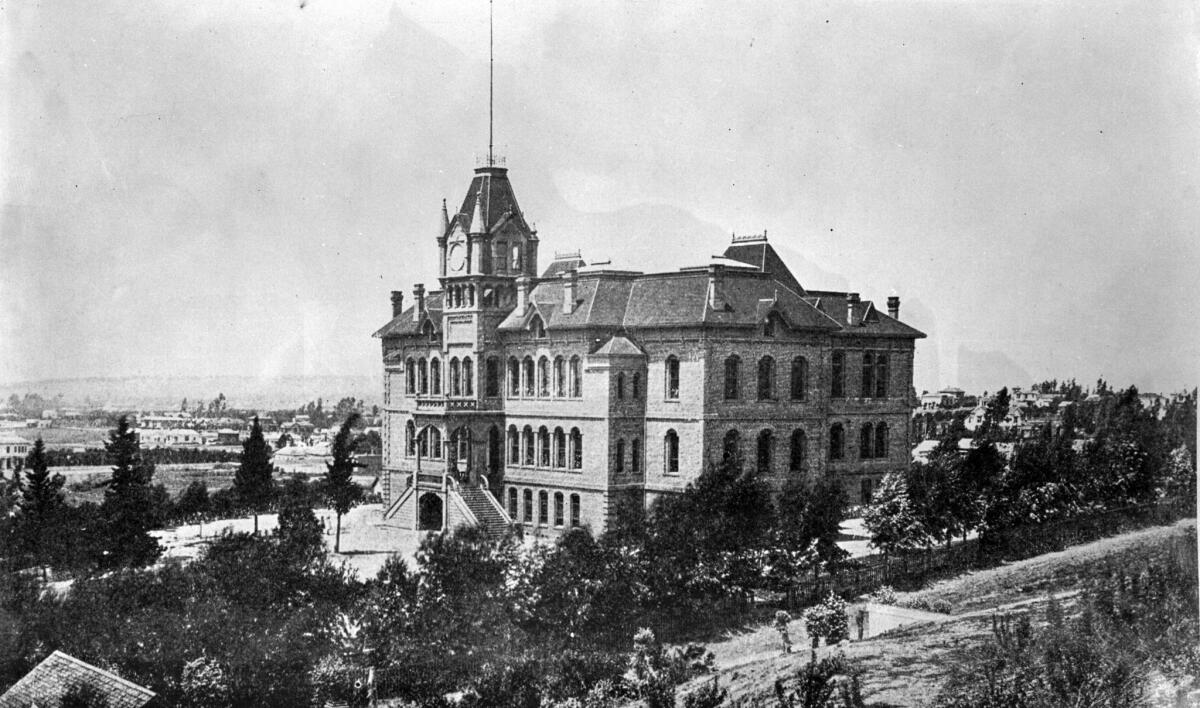
1882: Los Angeles Normal School, created to train teachers, opens on a site that is now the home of L.A. Central Library. It is demolished in 1924.
1880-90s: More mansions and hotels are constructed, including the Melrose, at 138 S. Grand, first built as a private residence and later converted to a hotel.
1887: Grand Avenue is officially launched when the City Council renames Charity Street.
Late 1880s: The Castle, a 20-room mansion with a “magnificent stained-glass front door,” is built at 325 S. Bunker Hill Ave. Eventually, it becomes a boarding house. Nearby, a house called the Salt Box is constructed at 339 S. Bunker Hill Ave. Decades later, they are famously photographed — in front of the towering Union Bank Building — after most of the neighborhood has been torn down or bulldozed. The images of these Victorian-era structures become a memorable entry in the history of Bunker Hill.
1898: The city of Los Angeles gets its first symphony orchestra.
1900-40
1900: The heyday of Bunker Hill as a fashionable enclave is over, as wealthy Angelenos leave for more prestigious neighborhoods. Residents in search of low-income housing move into some of the old Victorian mansions that have been converted into boarding houses.
1901: Angels Flight, a funicular, opens, moving passengers between the business district and Bunker Hill.
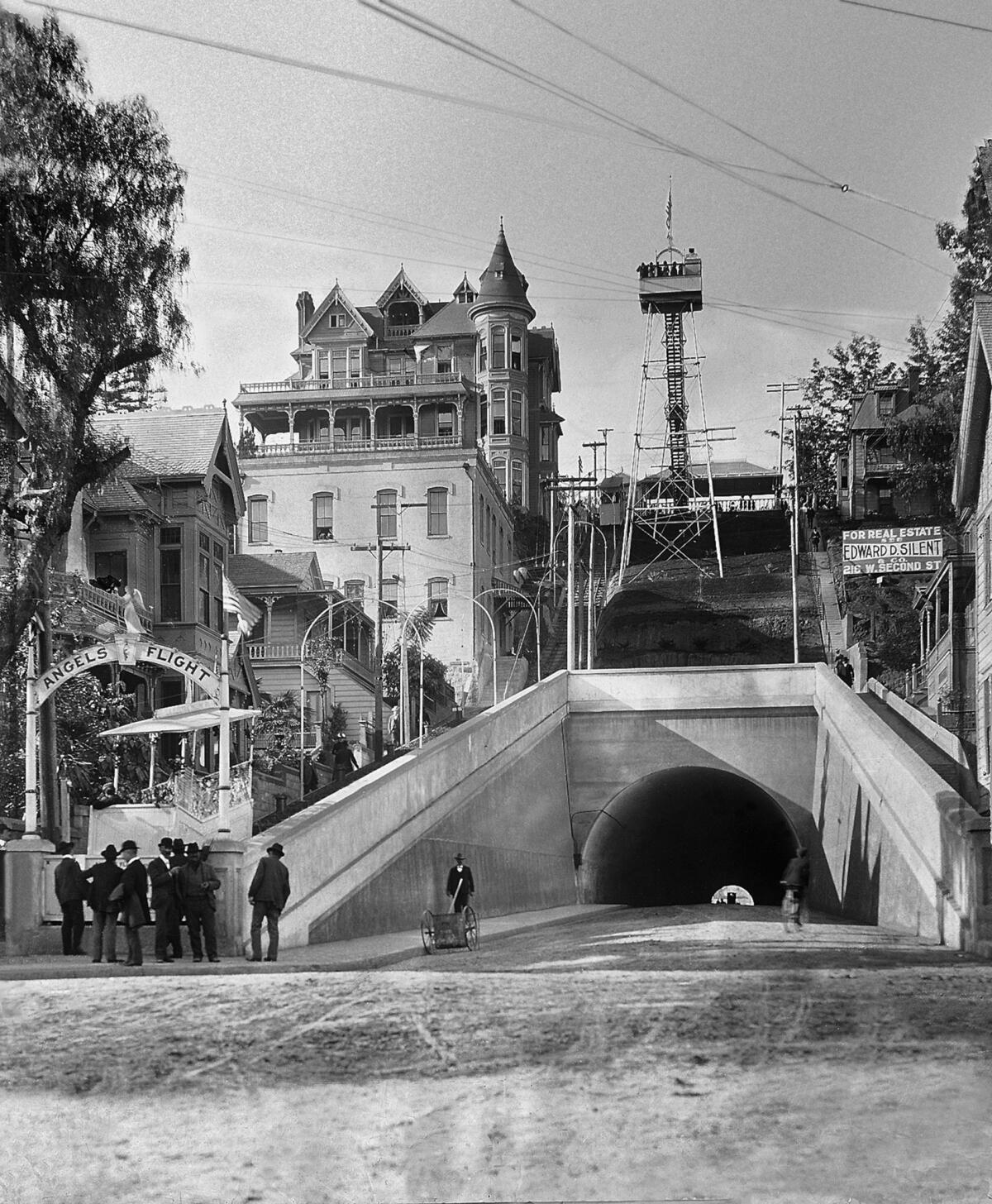
1901: The 3rd Street tunnel opens.
1902: The elegant Fremont Hotel, named after politician/explorer/soldier John C. Fremont, opens on the corner of Olive and 4th streets with about 100 rooms. It is torn down in 1955.
1924: The 2nd Street tunnel opens.
1926: The Central Library is constructed.
1928: Los Angeles City Hall opens.
1931: A group of “realty experts” submits to the city a plan to raze Bunker Hill properties and re-grade the hill at a cost of $24 million, using public funds and leasing portions of the land to private developers.
1940-60
1940s: More Bunker Hill mansions are converted to rooming houses.
1942: In “The High Window,” Raymond Chandler assesses the neighborhood: “Bunker Hill is old town, lost town, shabby town, crook town. Once, very long ago, it was the choice residential district of the city, and there are still standing a few of the jigsaw Gothic mansions.... They are all rooming houses now, their parquetry floors are scratched and worn through the once glossy finish and the wide sweeping staircases are dark with time and with cheap varnish laid on over generations of dirt.”
1945: California’s Community Redevelopment Law enables cities to use eminent domain to condemn and tear down dilapidated districts and encourage new development.
1948: The city of Los Angeles establishes its own Community Redevelopment Agency.
1949: President Harry S. Truman signs the Federal Housing Act. The legislation, Truman says, “opens up the prospect of decent homes in wholesome surroundings for low-income families now living in the squalor of the slums.” In truth, the act helps agencies acquire “blighted” areas of Bunker Hill, land that is cleared and redeveloped. Critics point out that it ruins established residential neighborhoods.
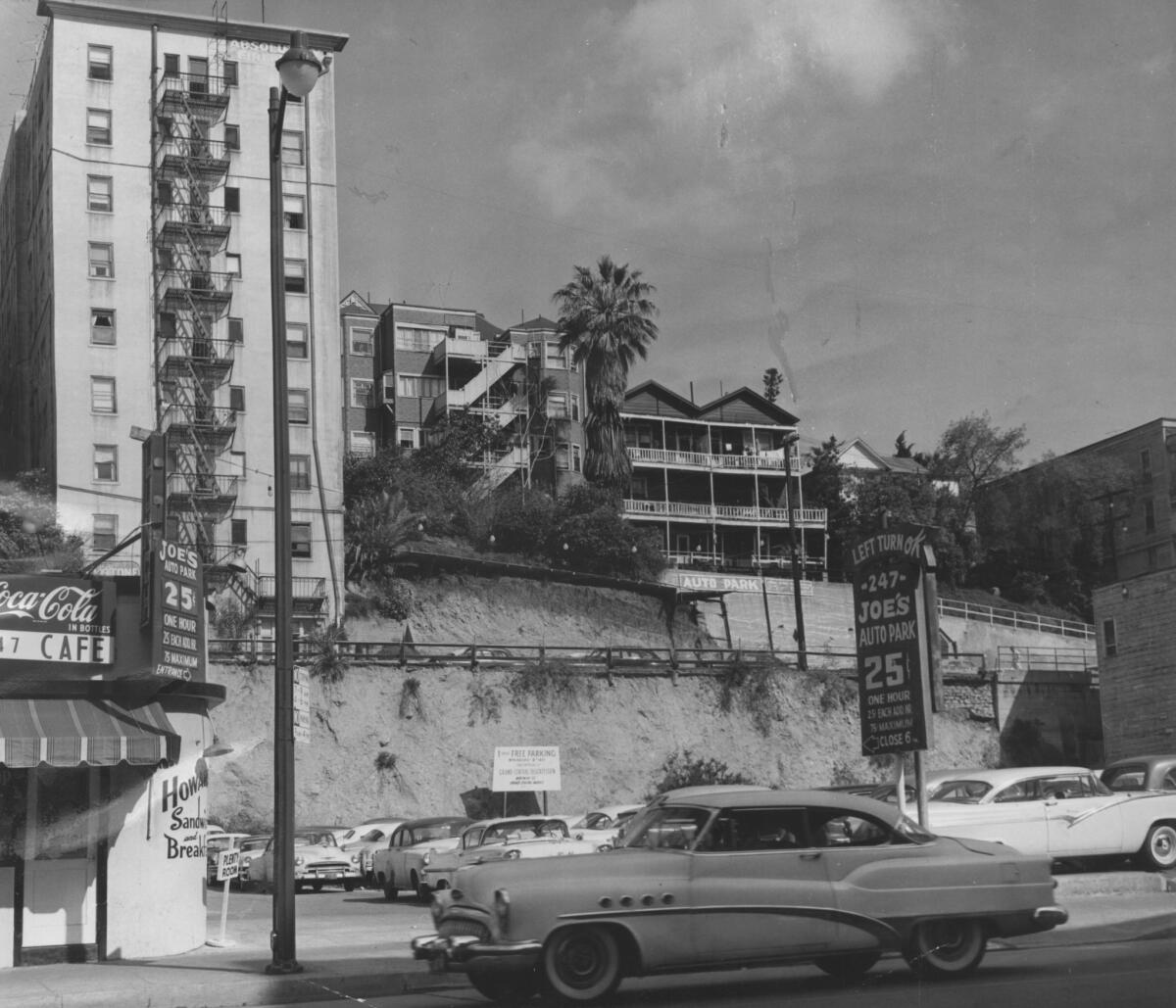
1956: The CRA presents a tentative plan (including “luxurious apartment-hotels ... along with smaller apartments for middle-income families and 13-story apartment buildings for single office workers”) to redevelop 135 acres of the Bunker Hill area “classified by local and federal authorities as a slum and substandard housing area,” according to a report in the Los Angeles Times.
1959: The city of Los Angeles adopts the Bunker Hill Urban Renewal Project. According to Curbed Los Angeles, “The redevelopment project adopted by the city on March 31, 1959, grew out of an urban revival movement sweeping the nation and kick-started by federal housing acts that offered aid for the clearing of ‘urban blight.’” Opponents slowed it down but couldn’t stop it. “Six-thousand residents, mostly poor people and senior citizens eligible for public housing, were relocated outside of the area; the promised replacement affordable housing never materialized.”
1960-80
1963: A “razing program” underway for 2 ½ years makes Bunker Hill a patchwork of vacant lots and gaping parcels.
1964: Memorial Pavilion, the first building of the Music Center, opens in December (it will eventually be re-christened as the Dorothy Chandler Pavilion). First-week performances include the Count Basie Orchestra, Van Cliburn and Frank Sinatra.
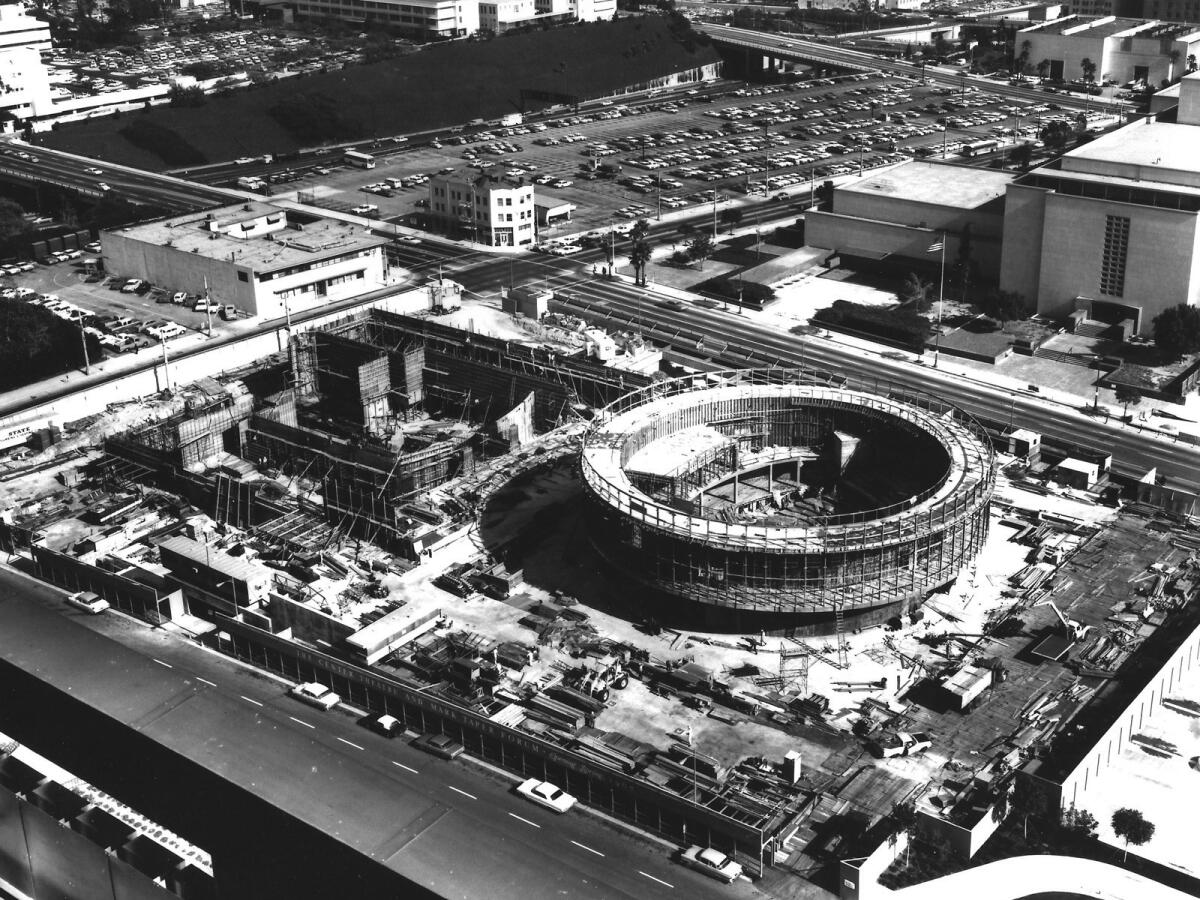
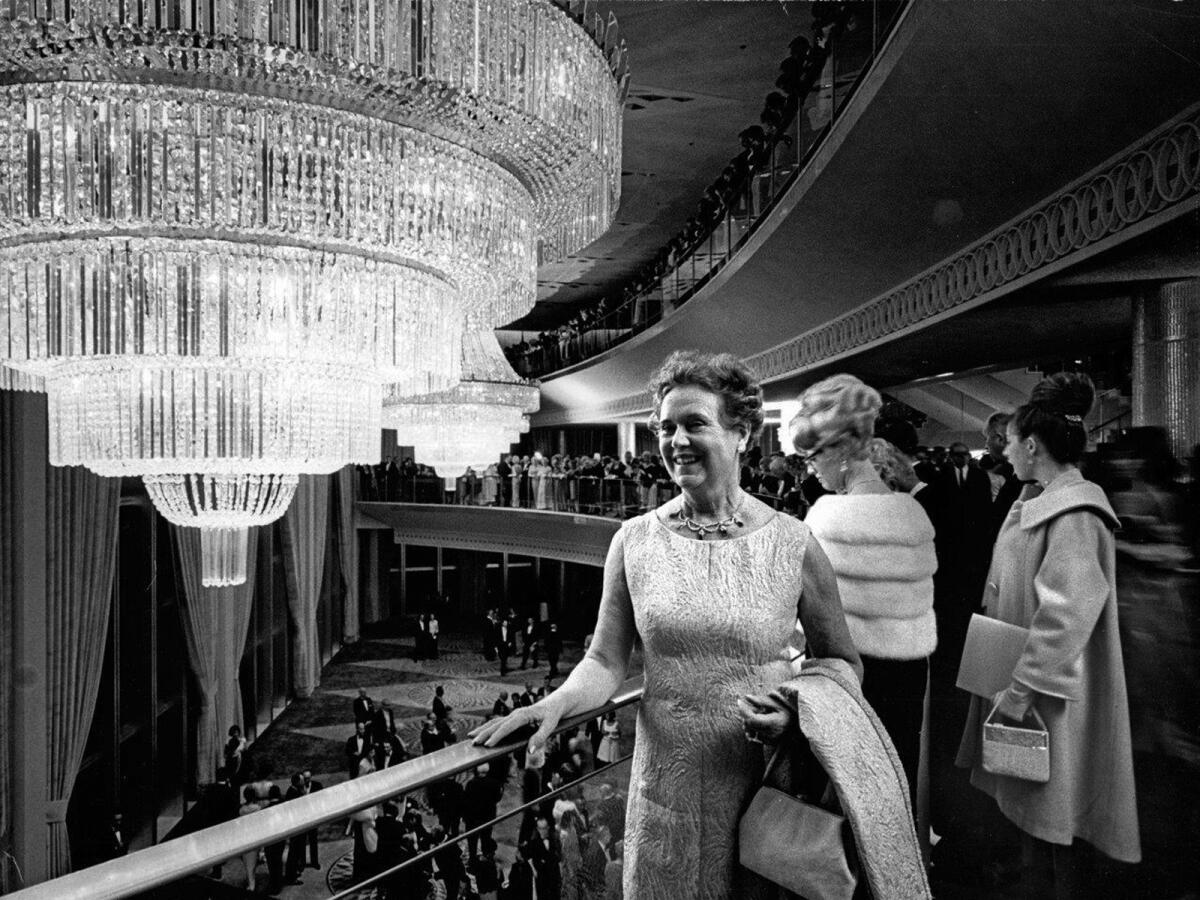
1965: L.A. County Board of Supervisors names the Music Center buildings — the Dorothy Chandler Pavilion, Mark Taper Forum and Ahmanson Theatre.
1966: First phase of the Los Angeles Civic Center Mall is dedicated — a $6.9-million segment between Grand Avenue and Hill Street between the courthouse and the Hall of Administration. A central feature is the Arthur J. Will Memorial Fountain, which is retained in the redesign years later of Grand Park.
1967: The Mark Taper Forum opens on April 9, with the controversial presentation of John Whiting’s “The Devils,” dramatized from Aldous Huxley’s famous factual study, “The Devils of Loudun,” and staged by Gordon Davidson.
1967: Inaugural performances of “Man of La Mancha” open the Ahmanson Theatre in April.
1967: The newly formed Los Angeles Music Center Opera Assn. commits to bringing the principal New York City Opera company, not the traveling company, for a month-long engagement to perform at the Music Center. That arrangement continues for 16 years.
1969: The CRA dismantles Angels Flight and puts it in storage, in preparation for the development of the California Plaza office complex on Grand Avenue.
1969: The Academy Awards are held for first time — and broadcast worldwide for the first time — at the Dorothy Chandler Pavilion. The best picture is “Oliver!”
1969: “Erector set” parking lot opens with 1,062 spaces at the corner of 1st and Olive streets, backing onto the length of Grand Avenue. It was often cited as one of Los Angeles’ most reviled structures, but at the time, the designer, engineer Charles Bentley, was marketing what he called a “revolutionary concept”: a low-cost portable parking structure that could be erected in a matter of weeks over an existing lot and taken down and moved as land uses changed. It will be torn down in 2018 as plans proceed for a $1-billion Frank Gehry-designed mixed-use development, scheduled for completion in 2021.
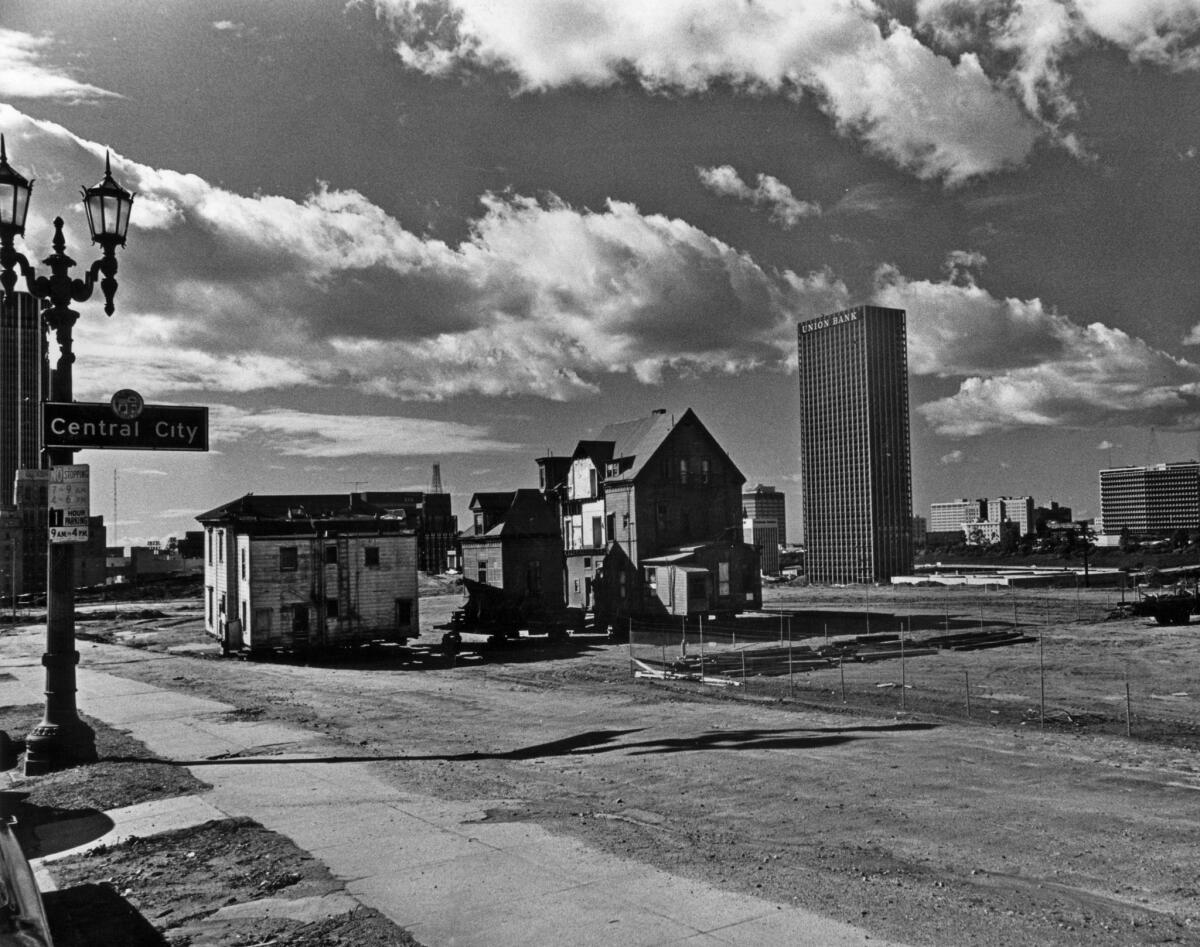
1969: The last two Victorian houses on Bunker Hill (the Castle and the Salt Box) are moved. They are to be the first structures in a new Heritage Square in Montecito Heights. On Oct. 9, both structures are destroyed in an arson fire.
1979: The Museum of Contemporary Art is officially founded. The CRA makes building a “Los Angeles Museum of Modern Art” a condition of the huge Bunker Hill Project (later known as California Plaza), requiring that 1.5% of the total cost must go into the museum building.
1980-2000
1980: MOCA continues the process of assembling an international board of trustees, including Dominique de Menil, who goes on to create the Menil Collection in Houston; Peter Ludwig from Germany; Italian lawyer Count Giuseppe Panza di Biumo; Seiji Tsutsumi from Japan; and L.A. artists Robert Irwin and Sam Francis.
1981: Japanese architect Arata Isozaki is selected to design the Museum of Contemporary Art on Grand Avenue.
1983: Public opening of MOCA’s Temporary Contemporary is celebrated in Little Tokyo. The inaugural show is “The First Show: Painting and Sculpture From Eight Collections 1940-1980.”
1984: With a budget of just $6.4 million, Peter Hemmings becomes the first executive general director of Music Center Opera (later renamed Los Angeles Opera), mounting five productions at the Dorothy Chandler Pavilion in a first season (launched two years later) that immediately makes the operatic world take notice.
1985: Tower 1 of California Plaza, a 1-million-square-foot, 42-story, $200-million building at 300 S. Grand Ave., is completed.
1986: An arson fire guts the Central Library, destroying 400,000 books and damaging another 700,000. Damages are estimated at $22 million, more than $50 million in today’s dollars.
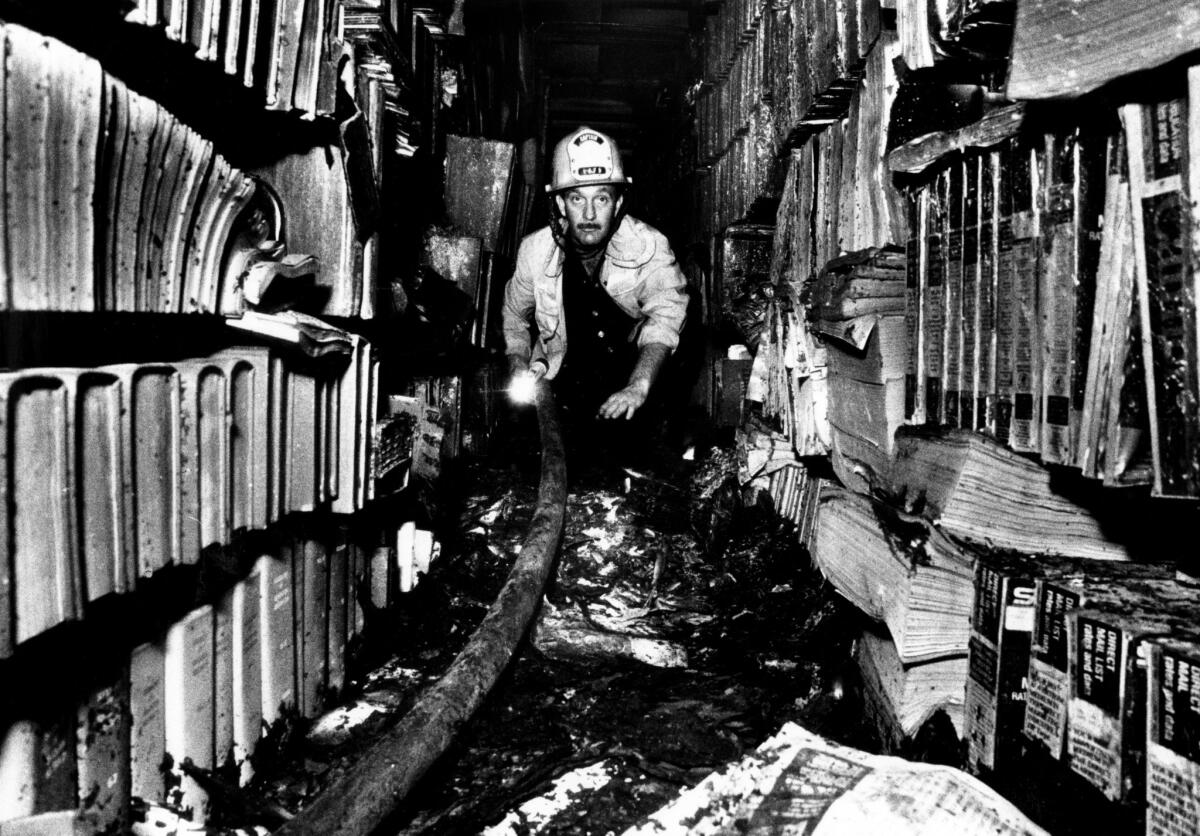
1986: Music Center Opera (later L.A. Opera) opens its inaugural season in October with Verdi’s “Otello,” starring Placido Domingo.
1986: Arata Isozaki’s $23-million MOCA opens on Grand Avenue in December, with “Individuals,” an ambitious survey of contemporary art, from Abstract to Neo-Expressionism in 400 works by 77 artists. (Isozaki is awarded the Pritzker Prize in 2019.)
1987: Lillian Disney, widow of Walt Disney, offers initial $50 million to create what will become Walt Disney Concert Hall.
1988: Frank Gehry is selected to build Walt Disney Concert Hall. (In 1989, Gehry is awarded the Pritzker Prize.)
1990: U.S. Bank Tower opens, at the time the tallest (73 stories) building on the West Coast. Originally called Library Tower, it is part of a city-approved project to allow a developer to build two skyscrapers in exchange for a guarantee to fund the renovation and expansion of the Central Library, which was gutted by fire in 1986.
1991: Frank Gehry unveils the final shape of his Disney Hall design. The estimated price tag is $110 million, but the final cost is more than double the estimate.
1992: Esa-Pekka Salonen becomes music director of the Los Angeles Philharmonic.
1992: Tower 2 of California Plaza, a $326-million, 52-story skyscraper, is completed.
1994: Construction on Walt Disney Concert Hall is stopped by officials so they can study ways to manage spiraling costs.
1996: Eli Broad and Mayor Richard Riordan step in to launch a new fundraising effort for Disney Concert Hall. The final cost is estimated at $255 million.
1996: Angels Flight is reopened, close to its original location, by a nonprofit group after being closed for 27 years.
1996: Cardinal Roger M. Mahony announces he wants to construct a Roman Catholic cathedral on a large county-owned plot of land in downtown Los Angeles between the county’s Hall of Administration on Temple Street and the Hollywood Freeway. Jose Rafael Moneo of Madrid, a Pritzker laureate, is named the architect.
1997: Frank Gehry threatens to quit the Walt Disney Concert Hall project after Eli Broad and Mayor Richard Riordan support a plan that will take the job of completing the working drawings for Disney Hall out of the hands of the architect’s firm. After an intervention by Diane Disney Miller, Gehry agrees to stay on.
1998: The Colburn School of performing arts is dedicated at its new home in a $28-million building alongside MOCA.
1999: Construction on Walt Disney Concert Hall begins. Final cost of building estimated at $274 million.
2000-19
2001: Los Angeles Unified School District hires the architecture firm A.C. Martin and Partners to prepare a preliminary design for a traditional high school on the site of the district’s old headquarters on Grand Avenue. Later in the year, philanthropist Eli Broad proposes a switch to an arts academy.
2001: An accident on Angels Flight kills an 83-year-old tourist. It is opened and closed several times — and reopened again in 2017.
2002: After Eli Broad helps to arrange a design competition for the proposed LAUSD arts academy at 450 N. Grand Ave., the jury makes its selection in September, announcing Coop Himmelblau as architects for the new high school.
2002: The Cathedral of Our Lady of the Angels is dedicated on Sept. 2. It is the first major American cathedral to be built in three decades.

2003: Giese Residence, a bedraggled wooden Queen Anne-style cottage built in 1887, located along West Cesar Chavez Avenue and known as “the last house in Bunker Hill,” is leveled illegally by a developer whose upscale apartment projects won praise for advancing downtown’s residential revival. In 2004, the developer and city agree to a settlement that includes — among other terms — a penalty to pay the city $200,000, which will be used to create a fund for low- and moderate-income families living in historic houses.
2003: Placido Domingo becomes general director of Los Angeles Opera.
2003: Disney Hall, Frank Gehry’s $274-million, 2,265-seat hall, opens in October, drawing ecstatic reviews from architecture and music critics across the country. Esa-Pekka Salonen conducts the hall’s first concert in front of an audience of politicians, Hollywood players, captains of industry and cultural savants.
2006: As costs escalate, the Los Angeles Unified School District board approves a nearly $172-million construction bid for the new visual arts school on Grand Avenue.
2007: L.A. County Board of Supervisors and the L.A. City Council give final approval to a $2.05-billion Grand Avenue project, a “sprawling mini-city atop Bunker Hill,” despite criticism about tax breaks and land giveaways. The first phase will be residential towers designed by Frank Gehry.
2007: The Colburn School expands with a $120-million, 12-story structure adjacent to its Grand Avenue headquarters. The expansion more than doubles the school’s size and marks a major step forward in its hopes of becoming the Juilliard of the West.
2008: MOCA acknowledges a financial crisis. Museum director Jeremy Strick says the museum is seeking large cash infusions from donors and does not rule out the possibility of merging with another institution or sharing its collection of almost 6,000 artworks.
2009: The California attorney general’s office determines that MOCA skirted state law for years, contributing to a financial meltdown in late 2008, and orders the museum to hire a consultant to help improve financial management. Overspending and investment losses drained MOCA’s investment portfolio from a peak of $38.2 million in mid-2000 to $5 million in December 2008. By March 2010, it rebounds to $14.2 million, fueled largely by fresh donations.
2009: Gustavo Dudamel starts his tenure as music director of the Los Angeles Philharmonic to great critical acclaim. His presence leads to long ticket lines and the rapid growth of “Dudamania” among fans.
2009: The steel-clad $232-million Ramon C. Cortines School of Visual and Performing Arts opens in September at 450 N. Grand Ave. Costs soared for the campus, rising ultimately past $230 million, compared with a 2001 $87-million estimate for the A.C. Martin version.
2010: Adding another contemporary art museum to Grand Avenue, Eli Broad announces that he will house his art collection in a downtown museum and eventually chooses a blue-chip New York architecture firm to design it — Diller Scofidio + Renfro. The announcement surprises some observers who believed Broad would donate his extensive collection to LACMA.
2012: The Music Center opens the long-awaited $56-million Grand Park in partnership with L.A. County. The 12-acre park stretches from Grand Avenue to City Hall.
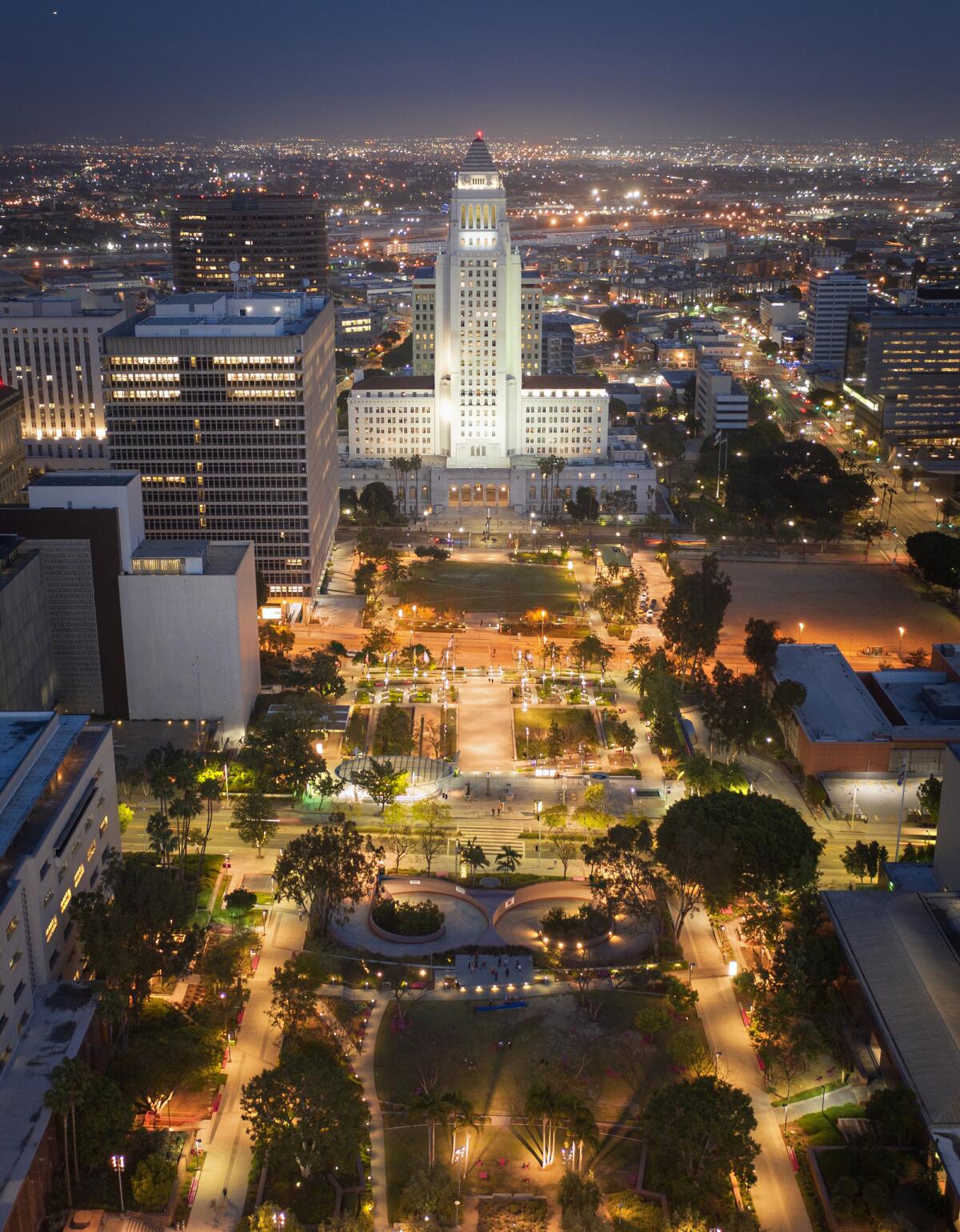
2013: More than 25,000 people attend Grand Park’s New Year’s Eve celebration.
2014: The Music Center celebrates its 50th anniversary.
2015: The Broad museum opens in September with 50,000 square feet of galleries.
2018: Frank Gehry is selected to design a campus extension for the Colburn School, including a 1,100-seat concert hall.
2018: The Los Angeles Philharmonic kicks off its centennial season in the fall.
2018: In June, developers propose plans for a mixed-use, 80-story skyscraper by Handel Architects — Angels Landing — on a site at 4th and Hill Streets, originally expected to hold the third office tower in California Plaza.
2019: In February, Frank Gehry, government officials and representatives of Related Cos. attend a ground-breaking ceremony for the Grand, the Gehry-designed mixed-use development across Grand Avenue from the Walt Disney Concert Hall.
Sources: Los Angeles Times, Curbed LA, Discover Los Angeles, Water and Power Associates, L.A. Forum, Los Angeles Downtown News, LAist, KCET
The biggest entertainment stories
Get our big stories about Hollywood, film, television, music, arts, culture and more right in your inbox as soon as they publish.
You may occasionally receive promotional content from the Los Angeles Times.







